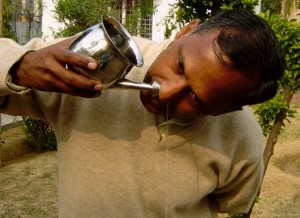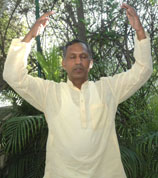What is Yoga?
Yoga is an ancient Indian science which is useful even today for people of any age, religion, country or in any profession. It is a science related to the body, mind and soul. It is not merely a set of physical exercises (asanas) as some people in the world believe.
Yoga has been divided into two parts. One is called “Ha” “Tha” Yoga and the other is called “Raja Yoga”. The former is mainly related to the physical body and the latter to the mind.
“Ha” “Tha” is a technical word and not a Hindi word. These two letters mean two types of different energies within a body. Yoga science believes that ailments or disorders are the result of imbalances of these two energies and the imbalances can be removed by Yogic Shatkarma, Asana, Pranayama, Mudra and Bandha.
Yogic shatkarma are highly effective cleansing processes for the physical body. At the same time, they are also simple and can be easily learnt. There are many methods described in the yoga scripture but today one needs to learn merely a few of them to stay healthy and young.
Asanas or yogasanas are a group of many simple and difficult physical exercises. One needs to learn a few of them to stay healthy according to one’s need, age, flexibility and strength. Difficult exercises are helpful to sportsmen, dancers, soldiers etc.
Mudras are also a group of asana but their method of doing is different.
Bandhas are also a group of a few simple physical exercises.
Pranayama is a science of regulation of the flow of pran. Pran is a technical word meaning an energy which keeps body and mind active, healthy, young and energetic. Pran has tremendous property to heal as well as to improve the quality of the functioning of both body and mind. Healing by pran is called Pran Upchaar in Hindi (also known as Pran Therapy or Aura Healing or Pranic Healing or Reiki Healing ). This healing method has done wonders in removing various ailments and problems. (see feedbacks of the patients). Pranayama plays a vital role in transforming the mind and helps in opening doors for the realization of the soul or Samadhi also. Kirlian photography has greatly helped in understanding the role of Pran in the functions of body and mind.
Since time immemorial asana, shatkarma, mudra, bandha, pranayama have benefitted innumerable patients by removing their physiological, psychosomatic and mental problems.
Raja Yoga aims at the attainment of the highest state of mind or Samadhi. Maharishi Patanjali has written a beautiful book for this purpose “Yoga Darshan”. He says that one needs to practise eight steps in all for the attainment of Samadhi (merely knowing cannot help) and that is why his method is called Ashtang Yoga. Ashtang is a Hindi word meaning eight. These eight steps are Yama, Niyama, Asana, Pranayama, Pratyahar, Dharna, Dhyan and Samadhi.
Yoga is, in fact, a science for purifying and sanctifying the mind. Maharishi Patanjali also says that it is a science to discipline and calm the mind. He defines eight parts of yoga as under :-
Yama aims at making the mind non-violent to inculcate love and compassion; truthful to develop courage and remove fear; honest in money matters to avoid greed; conserving all sorts of physical and mental energies to avoid their waste and to strengthen will power; and avoiding accumulation of money to make life simple.
Niyama aims at cleaning the physical, subtle, mental body to keep ailments away; contentment to keep mind calm and happy; perseverance to avoid depression; study of scriptures related to mind, soul and God; surrender to God to avoid egoism.
Yama and Niyama together aim at teaching the right way of living to help you develop spiritually, emotionally, intellectually and socially. They help in the development of a balanced personality and a good human being.
Asanas aim at enabling the body to sit ‘comfortably and steadily’ for hours at a stretch for the practice of meditation.
Pranayama means natural regulation of pran.
Pratyahar develops control over all the senses to control the mind.
Dharna develops focussing ability of the mind.
Dhyan (Meditation) further enhances the focussing ability of mind. Practice of meditation gives immense peace and mental strength.
Samadhi is the culmination of practice of meditation into realization of soul or samadhi or ultimate truth…
Home | Pavan Jain | Courses | Prana Therapy | Photos | Feedback | Contact






You must be logged in to post a comment.